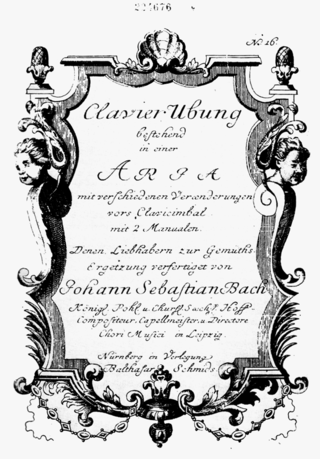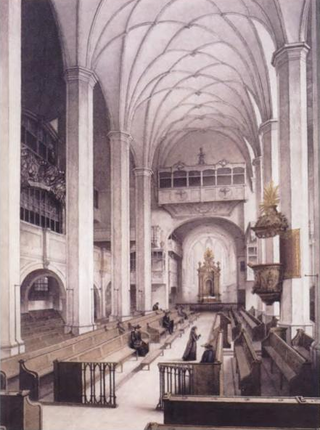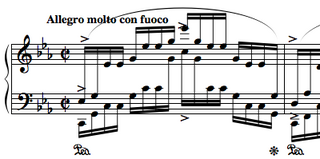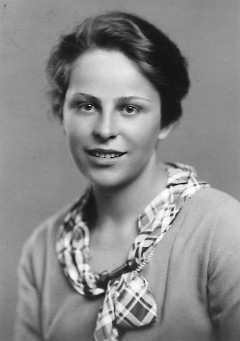
The Goldberg Variations, BWV 988, is a musical composition for keyboard by Johann Sebastian Bach, consisting of an aria and a set of 30 variations. First published in 1741, it is named after Johann Gottlieb Goldberg, who may also have been the first performer of the work.

Geist und Seele wird verwirret, BWV 35, is a church cantata by Johann Sebastian Bach. He composed the solo cantata for alto voice in Leipzig for the twelfth Sunday after Trinity and first performed it on 8 September 1726.
An air is a song-like vocal or instrumental composition. The term can also be applied to the interchangeable melodies of folk songs and ballads. It is a variant of the musical song form often referred to as aria.
The siciliana[sitʃiˈljaːna] or siciliano[sitʃiˈljaːno] is a musical style or genre often included as a movement within larger pieces of music starting in the Baroque period. It is in a slow 6
8 or 12
8 time with lilting rhythms, making it somewhat resemble a slow jig or tarantella, and is usually in a minor key. It was used for arias in Baroque operas, and often appears as a movement in instrumental works. Loosely associated with Sicily, the siciliana evokes a pastoral mood, and is often characterized by dotted rhythms that can distinguish it within the broader musical genre of the pastorale.

Karl Tausig was a Polish virtuoso pianist, arranger and composer. He is generally regarded as Franz Liszt's most esteemed pupil, and one of the greatest pianists of all time.

Halt im Gedächtnis Jesum Christ, BWV 67, is a church cantata by Johann Sebastian Bach. He composed it in Leipzig for Quasimodogeniti, the first Sunday after Easter, and first performed it on 16 April 1724.

Weinen, Klagen, Sorgen, Zagen, BWV 12, is a church cantata by Johann Sebastian Bach. He composed it in Weimar for Jubilate, the third Sunday after Easter, and led the first performance on 22 April 1714 in the Schlosskirche, the court chapel of the Schloss in Weimar.
Kevin John Bowyer is an English organist, known for his prolific recording and recital career and his performances of modern and extremely difficult compositions.

"Alles mit Gott und nichts ohn' ihn", BWV 1127, is Johann Sebastian Bach's October 1713 setting of a poem in 12 stanzas by Johann Anton Mylius, Superintendent of Buttstädt, a town in the Duchy of Saxe-Weimar. The poem is an acrostic dedicated to Duke Wilhelm Ernst of Saxe-Weimar, on his birthday. Bach, at the time employed as court organist by the Duke, set Mylius's ode as an aria in strophic form, that is a melody for soprano accompanied by continuo for the stanzas, alternated with a ritornello for strings and continuo. When all stanzas are sung, a performance of the work takes around 45 to 50 minutes.

Étude Op. 25, No. 12 in C minor is the last of Frédéric Chopin's formal studies for the piano, opus 25, dedicated À Madame la Comtesse d'Agoult. It was first published in 1837 in French, German, and English. In the first French edition, the time signature is 4/4, but most recent editions of this piece follow the manuscript and German editions, which indicate cut time. This work is a series of rising and falling arpeggios in various chord progressions from C minor. In addition, its opening bars recall the chord structure of the opening bars of the second prelude of the first book of The Well-Tempered Clavier by Johann Sebastian Bach.

Johann Sebastian Bach was a German composer and musician of the late Baroque period. He is known for his orchestral music such as the Brandenburg Concertos; instrumental compositions such as the Cello Suites; keyboard works such as the Goldberg Variations and The Well-Tempered Clavier; organ works such as the Schubler Chorales and the Toccata and Fugue in D minor; and vocal music such as the St Matthew Passion and the Mass in B minor. Since the 19th-century Bach revival he has been generally regarded as one of the greatest composers in the history of Western music.

Isolde Ahlgrimm was an Austrian harpsichordist and fortepianist. In 1975 she was awarded the Austrian Gold Medal.

The Partita No. 3 in E major for solo violin, BWV 1006.1, is the last work in Johann Sebastian Bach's set of Sonatas and Partitas. It consists of the following movements:
- Preludio
- Loure
- Gavotte en Rondeau
- Menuets
- Bourrée
- Gigue

The Bach-Busoni Editions are a series of publications by the Italian pianist-composer Ferruccio Busoni (1866–1924) containing primarily piano transcriptions of keyboard music by Johann Sebastian Bach. They also include performance suggestions, practice exercises, musical analysis, an essay on the art of transcribing Bach's organ music for piano, an analysis of the fugue from Beethoven's 'Hammerklavier' sonata, and other related material. The later editions also include free adaptations and original compositions by Busoni which are based on the music of Bach.

Johann Sebastian Bach composed the church cantata Ich glaube, lieber Herr, hilf meinem Unglauben, BWV 109, in Leipzig for the 21st Sunday after Trinity and first performed it on 17 October 1723.

Nimm, was dein ist, und gehe hin, BWV 144, is a church cantata by Johann Sebastian Bach. He composed it in Leipzig for the Sunday Septuagesimae, the third Sunday before Lent, and first performed it on 6 February 1724.

Erhöhtes Fleisch und Blut, BWV 173, is a church cantata by Johann Sebastian Bach. He composed it in Leipzig for Pentecost Monday and first performed it on 29 May 1724.
Lobe den Herrn, meine Seele, BWV 143, is an early cantata by Johann Sebastian Bach. He appears to have composed the cantata for New Year's Day, probably when he was in his 20s, but whether it was first performed in Mühlhausen or Weimar is not known: the date of composition is unclear. Bach's authorship has been doubted because the cantata has several ununusual features; one of these is the scoring, it is the only Bach cantata to combine three corni da caccia with timpani.
The International Piano Competition J. S. Bach, Würzburg is a triennial piano competition that is held in Würzburg, Germany. It was founded by Walter Blankenheim, with the inaugural competition being held in 1992. With 825 competitors from 59 countries, it is the largest Bach piano competition in the world, and the only international Bach piano competition where the repertoire consists of only the works of J. S. Bach.
Jae-Yeon Won is a South Korean pianist. He won the second prize and the audience prize at the 61st Ferruccio Busoni International Piano Competition in 2017 and was a laureate at the Long-Thibaud-Crespin Competition in 2012.














